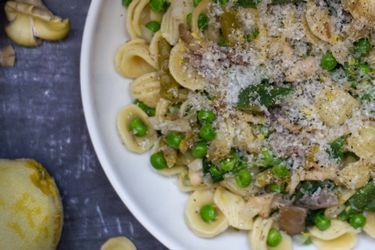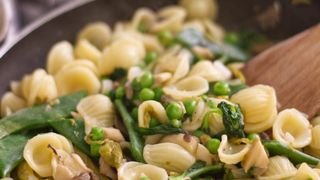If you enjoy this article, or any other content from this website, please subscribe to the newsletter. Your support can make a big difference!
Spring is finally here and I couldn't be happier. I have to say that I did escape the worst of the Italian winter, having spent most of it in Malta, but I am still struggling with my first proper winter after having spent almost two years in tropical Singapore.
In celebration of this wonderful season, I decided to cook one of my favourite pasta — orecchiette (which incidentally also reminds me of warm weather). This pasta from Puglia, a southern region of Italy, is named for its shape, and translates to “little ear”. I luckily got to witness grannies on the quaint streets of Bari selling their handmade orecchiette, making this little pasta all the more special. I couldn't resist and had to grab myself a handful.
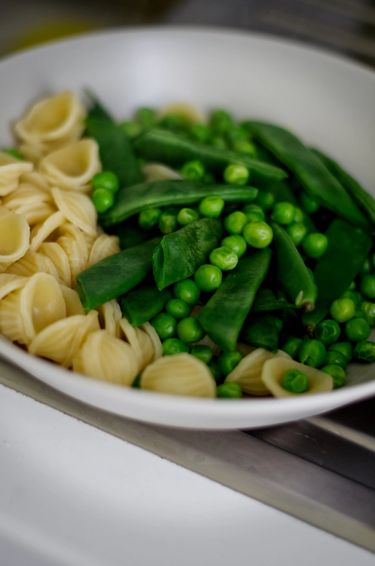
Back to the topic of spring, one of my favourite spring vegetables is English peas. I could just snack on English peas all day, to the point that I used to receive warnings from my mother, that too many would give me a stomach ache (not sure that was correct but it was enough to control my greed). However, these are not the only peas that make an appearance in the springtime many of which are similar, oftentimes requiring some clarification. Here's mine.
Find Your Inner Peas with this Guide
Let's dive into the difference between the most common peas: English peas, sugar snap peas, snow peas, and pea shoots.
English Peas
Also known as shelling peas or garden peas, these are the same peas that are frozen. The pod isn't eaten, just the peas inside. Yet you can actually use the pods for a spring vegetable stock to maximise on the plant.
Pea Shoots
The edible stems, leaves, and curly tendrils of pea plants have a delicate texture and subtle flavour that make them worth snapping up at the market. I enjoy eating them fresh but they can also be sautéed.
Snow Peas
Part of the category of legumes known as mange-touts, or "eat all," these flat green pods, which hold small peas, are entirely edible. They can be enjoyed raw, but they are also excellent cooked, such as in stir-fries or blanched or sautéed.
Sugar Snap Peas
Now here comes the confusing bit. Sugar Snap Peas have only been around since the 1970s. They're a hybrid, resulting in plump pods that are crisp, and sweet and can be eaten both raw or cooked, making them extremely versatile.
Snap peas and English peas can be confused because both have round peas in a pod but snap pea pods are smaller and the pod is thinner.
Remember to choose peas that are fresh and young—this is not a time when bigger is better. Peas should also be recently picked, because If left on the plant for too long, those sugars are converted into starches so the peas become fibrous and tough with a less sweet flavour.
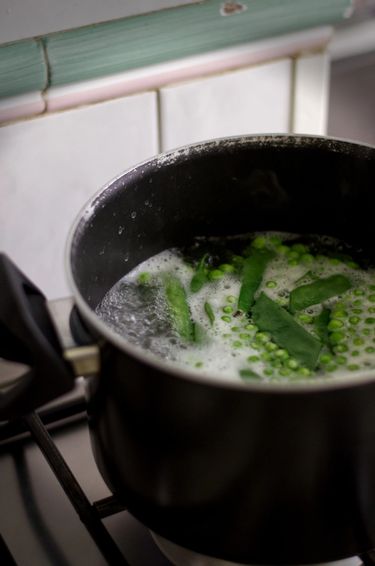
Making this wonderful spring pasta salad
This simple vegetarian orecchiette pasta sings of spring. This pasta dish is super easy to make and will come together in about 30 minutes. Perfect for weeknights!

As I mentioned, I choose orecchiette pasta as these small round “ears” are perfect for cradling the green peas but you could use any type of pasta such as rigatoni. I would advise against spaghetti though because this is not a saucy dish.
The fresh ingredients used for this pasta salad are:
- English peas (you can use frozen if you can't find fresh)
- Romano beans (you can use french beans or sugar snap beans if you prefer)
- Wild mushrooms (or better yet, check out how to grow your own mushrooms at home)
- Wilting greens (like spinach, chard, etc.)
- Asparagus tips
- Lemon zest for some brightness.
What are Romano Beans?
For those who don't know, Romano beans are an Italian flat bean in the same family as garden variety string beans. They’re broad and flat with a juicy, sweet flavour and great crunch. You can eat these snappy beans raw but also cooked, whether quickly blanched for crudités, charred on the grill and dressed with lemon juice and olive oil, or slow-braised in a tasty broth so they plump up and soak up all that flavour.

How to Make a Creamier Version of this Primavera Pasta
As I wanted to keep calories low, I kept this dish simple. However, if you want to have this as a creamy pasta, you can choose to add a few tablespoons of cream. Alternatively, you can do it the 'carbonara' way which is by tempering eggs.
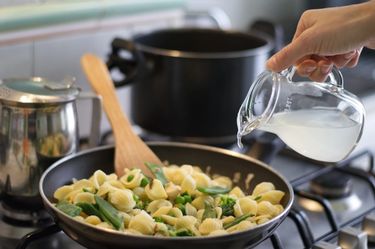
First, you'd need to whisk one egg (if making for two persons), then temper it by adding cooled pasta water (which contains starch from the pasta) one tablespoon at a time. Make sure the pasta water has cooled long for long enough as you risk cooking the egg when you mix it together. Once you've mixed well, pour the tempered egg over the pasta with a wooden spoon, gently coating the pasta. Make sure the pasta is being cooked on very low heat at that point, once again to avoid cooking the egg.
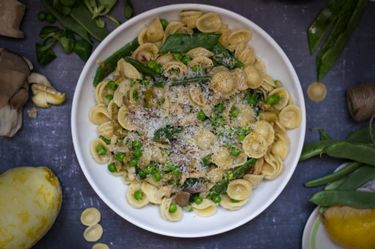
Spring Orecchiette Pasta with Peas, Beans and Wild 'Shrooms
3 reviews
Description
A 30-minute pasta dish with peas, beans and wild mushrooms
Information
- Servings
- 2portions
- Preparation time
- 10minutes
- Cooking time
- 20minutes
Ingredients
- 150grOrecchiette pasta
- 100grEnglish peas
- 50grRomano beans
- —half medium onion, diced
- 100grWild mushrooms
- 50grasparagus tips
- 50grWilting greens (e.g. rocket, lambs lettuce, chard, spincach etc.)
- —grated parmesan (or pecorino), to taste
- —lemon zest, to taste
- —salt and pepper, to taste
Method
1. Cook the Pasta
Bring a large pot of generously salted water to a boil. When water comes to a boil, add pasta and cook to al dente, about 7 minutes (see directions on package). During the last minute of cooking the pasta, add the fresh peas, fresh asparagus tips, and beans to the boiling pasta, turn the heat up to high, and quickly blanch for one minute. Drain the pasta and veggies (reserving a couple of tablespoons of hot pasta water). Do not rinse. Return to the pot, turn the heat off.
2. Sauté the vegetables
While the pasta is cooking, sauté the mushrooms. In a skillet, heat 1 tablespoon of oil over medium heat. Sauté the onion until tender and fragrant, 3-4 minutes. Add mushrooms and sauté until golden and tender. Add a pinch of salt and pepper. Add the wilting greens and sauté, stirring often until just wilted. Set the pan aside.
3. Mix the pasta
Add the pasta to the pan with the sautéed veg adding hot pasta water as needed to loosen the pasta.
Note: if you wish to make this pasta dish creamier, read the blog post section titled 'How to Make a Creamier Version of this Primavera Pasta'.
4. Prepare the pasta for serving
Taste and adjust the salt and pepper to your liking. Once done, place on a platter or bowl and sprinkle with lemon zest and parmesan. Serve immediately!
